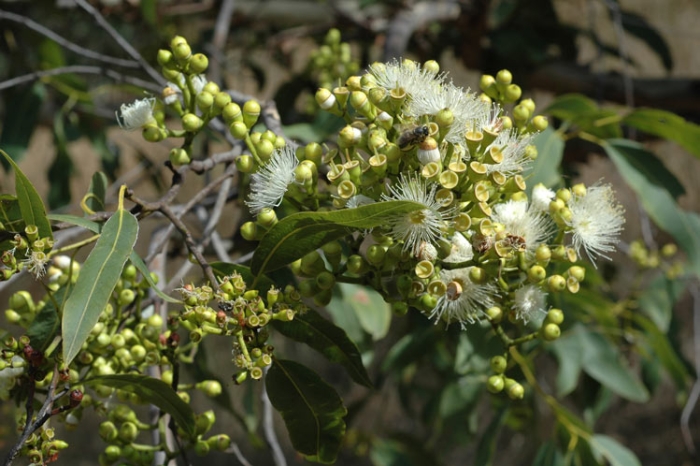Cadaghi
(Corymbia torelliana)
Cadaghi (Corymbia torelliana)
/
/

Murray Fagg
CC BY 3.0 au
Image By:
Murray Fagg
Recorded By:
Copyright:
CC BY 3.0 au
Copyright Notice:
Photo by: Murray Fagg | License Type: CC BY 3.0 au | License URL: https://creativecommons.org/licenses/by/3.0/au/deed.en | Uploader: Gderrin | Publisher: Wikimedia Commons | Title: Corymbia_torelliana_buds.jpg | Notes: {{Information| |Description=Cotinus obovatus: Habit |Source=Own photo, taken Botanical Garden, Jutland. |Date=22.5.2007 |Author=[[User:Sten|Sten Porse]] |Permission={{self2|GFDL|cc-by-sa-2.5,2.0,1.0}} |other_versions= }} [[Category:Cotinus]] [[C |


















































Estimated Native Range
Summary
Corymbia torelliana, commonly known as Cadaghi or Blood-Leaf Gum, is an evergreen tree native to the coastal rainforests and moist eucalypt forests of Queensland, Australia. It can grow to a height of 25–30 meters (82–98 ft) with a broad crown and forms a lignotuber, which allows it to resprout after damage. The bark is smooth, greenish-grey to white, becoming rough at the base in older trees. Adult leaves are egg-shaped, heart-shaped, or lance-shaped, providing a dense canopy. Flower buds appear in groups of three or seven, leading to showy white flowers from August to November, followed by urn-shaped or shortened spherical fruit.
Cadaghi is valued for its rapid growth and dense foliage, making it suitable for shade and shelter in large gardens and parks. It is also used for honey production and as a street tree in tropical and subtropical regions. However, it requires well-drained soils, consistent moisture, and full sun to part shade to thrive. While it is relatively low-maintenance, it can be susceptible to psyllid insects that produce lerps on the leaves. In some areas outside its native range, Corymbia torelliana has become invasive, so it is crucial to check local regulations before planting.CC BY-SA 4.0
Cadaghi is valued for its rapid growth and dense foliage, making it suitable for shade and shelter in large gardens and parks. It is also used for honey production and as a street tree in tropical and subtropical regions. However, it requires well-drained soils, consistent moisture, and full sun to part shade to thrive. While it is relatively low-maintenance, it can be susceptible to psyllid insects that produce lerps on the leaves. In some areas outside its native range, Corymbia torelliana has become invasive, so it is crucial to check local regulations before planting.CC BY-SA 4.0
Plant Description
- Plant Type: Tree
- Height: 60-80 feet
- Width: 20-25 feet
- Growth Rate: Moderate
- Flower Color: Cream
- Flowering Season: Spring
- Leaf Retention: Evergreen
Growth Requirements
- Sun: Full Sun, Part Shade
- Water: Medium
- Drainage: Medium
Common Uses
Bee Garden, Bird Garden, Butterfly Garden, Fragrant, Hummingbird Garden
Natural Habitat
Coastal rainforests and moist eucalypt forests of Queensland, Australia
Other Names
Common Names: Cadaga, Cadaghi
Scientific Names: , Eucalyptus torelliana, Corymbia torelliana,
GBIF Accepted Name: Corymbia torelliana (F.Muell.) K.D.Hill & L.A.S.Johnson